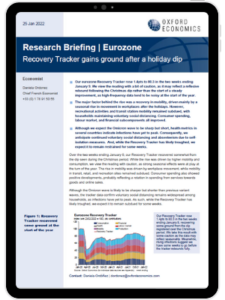Research Briefing
| Jan 25, 2022
Eurozone Recovery Tracker gains ground after a holiday dip

Our eurozone Recovery Tracker rose 1.4pts to 80.3 in the two weeks ending January 9. We view the reading with a bit of caution, as it may reflect a reflexive rebound following the Christmas dip rather than the start of a steady improvement, as high-frequency data tend to be noisy at the start of the year.
What you will learn:
- The major factor behind the rise was a recovery in mobility, driven mainly by a seasonal rise in movement in workplaces after the holidays.
- Although we expect the Omicron wave to be sharp but short, health metrics in several countries indicate infections have yet to peak.
- Consequently, we anticipate continued voluntary social distancing and absenteeism due to self-isolation measures.
Tags:
Related research

Post
US Rolls Up Welcome Mat for International Travel
Research Briefing Eurozone Recovery Tracker gains ground after a holiday dip Trump tariffs set to raise effective rate above 1930s levels.
Find Out More
Post
Initial takeaways from Trump’s ‘Liberation Day’ announcement
In two or three years' time, US imports could fall by around 15% due to discounted reciprocal tariff hikes.
Find Out More